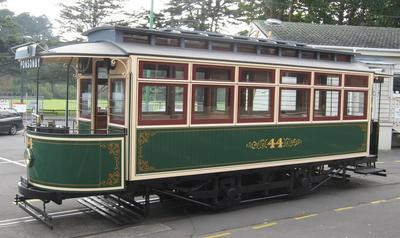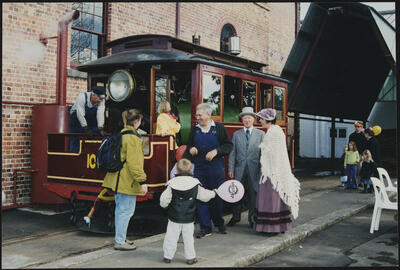Tram [Auckland No. 44 (A type 'Dinghy copy')]
Maker and role
Auckland Electric Tramways Company Limited, Manufacturer
Brush Electrical Engineering Company Limited, Manufacturer
Production date
1906
See full details
Object detail
Accession number
1964.111
Secondary maker and role
Brush Electrical Engineering Company Limited
Brush Electrical Engineering Company Limited
Brush Electrical Engineering Company Limited
The General Electric Company Limited
J G Brill Company
Brush Electrical Engineering Company Limited
Brush Electrical Engineering Company Limited
The General Electric Company Limited
J G Brill Company
Production period
Description
Auckland Electric Tramcar
A Class “Dinghy” No.44.
Single deck, two compartment,
Single truck
Bodywork: Auckland Electric Tramway Company Limited
Length: 29' 11", width: 7' 6", weight: 9.85 tons
Seating capacity 30, standing 10
Trolley standard: Stovepipe type by R W Blackwell
Glass fronts fitted and canopies rebuilt - 25/11/1910
Air brakes installed - 20/04/1912
Brakes strengthened - 04/01/1913
Sand gear installed - 20/04/1912
Coupled to car No.49 - 05/12/1918
Rebuilt - GE K6 controllers fitted - 31/02/1921
Original truck: Brush 4-wheel truck,
1435 mm gauge
Original motors: 2 x Brush 1200 @ 40 HP
Original Controllers: Brush H2, then General Electric K6 after being coupled 31st March 1921
Present truck: Brill copy 21E ex Brussels in Belgium, 4' 8 1/2" (1435mm) gauge
Present motors: 2 x MTV30 @ 70 HP (being re-rated to approximately 35-40 HP)
Present controllers: 2 x General Electric K35JJ.
A Class “Dinghy” No.44.
Single deck, two compartment,
Single truck
Bodywork: Auckland Electric Tramway Company Limited
Length: 29' 11", width: 7' 6", weight: 9.85 tons
Seating capacity 30, standing 10
Trolley standard: Stovepipe type by R W Blackwell
Glass fronts fitted and canopies rebuilt - 25/11/1910
Air brakes installed - 20/04/1912
Brakes strengthened - 04/01/1913
Sand gear installed - 20/04/1912
Coupled to car No.49 - 05/12/1918
Rebuilt - GE K6 controllers fitted - 31/02/1921
Original truck: Brush 4-wheel truck,
1435 mm gauge
Original motors: 2 x Brush 1200 @ 40 HP
Original Controllers: Brush H2, then General Electric K6 after being coupled 31st March 1921
Present truck: Brill copy 21E ex Brussels in Belgium, 4' 8 1/2" (1435mm) gauge
Present motors: 2 x MTV30 @ 70 HP (being re-rated to approximately 35-40 HP)
Present controllers: 2 x General Electric K35JJ.
Brief History
Tram no. 44 was constructed using mostly kauri in 1906 at the Auckland Electric Tramway Company Limited’s barn and workshops located in Jervois Road. It was the first tram in the Auckland fleet to be painted with the new colour scheme of Brunswick green and cream.
At this time, there was need a to get trams urgently into service. To speed up the building process, this tram body was placed on the 4-wheel truck (or chassis) of freight car No. 44, and it subsequently took this number. It went into service in December 1906 and operated mainly on the Herne Bay, Parnell, Newmarket line.
Its open front dates from the earlier days of the horse tram era. However, a modernisation programme was introduced which saw motorman’s windscreens installed and canopies rebuilt in November, 1910. Pneumatic “air” brakes and sanding gear were also later fitted in April, 1912.
The tram was based on the English-built ‘Dinghy’ style tram. They were known as ‘Dinghies’ because they bounced up and down end on end, due to the wheels being near the centre of the tram. From 1918, all Dinghies in the Auckland fleet were coupled in pairs, known as ‘Twins’. This allowed the trams to carry twice as many passengers. No. 44 was coupled with No. 49 and a motorman drove the front tram while each compartment had its own conductor. The Twins soon became uneconomic to operate and No. 44 and 49 were retired in June, 1931 and sold that same year.
No. 44 became part of MOTAT’s collection in 1963. The exterior has been restored to appear as it would have in 1906, with an open front. The interior appears as it did in 1921, rich with materials and fittings installed during its last rebuild. MOTAT volunteers won an award for the restoration of this tram in 2006.
At this time, there was need a to get trams urgently into service. To speed up the building process, this tram body was placed on the 4-wheel truck (or chassis) of freight car No. 44, and it subsequently took this number. It went into service in December 1906 and operated mainly on the Herne Bay, Parnell, Newmarket line.
Its open front dates from the earlier days of the horse tram era. However, a modernisation programme was introduced which saw motorman’s windscreens installed and canopies rebuilt in November, 1910. Pneumatic “air” brakes and sanding gear were also later fitted in April, 1912.
The tram was based on the English-built ‘Dinghy’ style tram. They were known as ‘Dinghies’ because they bounced up and down end on end, due to the wheels being near the centre of the tram. From 1918, all Dinghies in the Auckland fleet were coupled in pairs, known as ‘Twins’. This allowed the trams to carry twice as many passengers. No. 44 was coupled with No. 49 and a motorman drove the front tram while each compartment had its own conductor. The Twins soon became uneconomic to operate and No. 44 and 49 were retired in June, 1931 and sold that same year.
No. 44 became part of MOTAT’s collection in 1963. The exterior has been restored to appear as it would have in 1906, with an open front. The interior appears as it did in 1921, rich with materials and fittings installed during its last rebuild. MOTAT volunteers won an award for the restoration of this tram in 2006.
Marks
44 Painted
Media/Materials
Other name
Dinghy copy
Credit Line
Auckland Electric Tramways Company Limited et al. 1906. Tram [Auckland No. 44 (A type 'Dinghy copy')], 1964.111. The Museum of Transport and Technology (MOTAT).



Public comments
Be the first to comment on this object record.